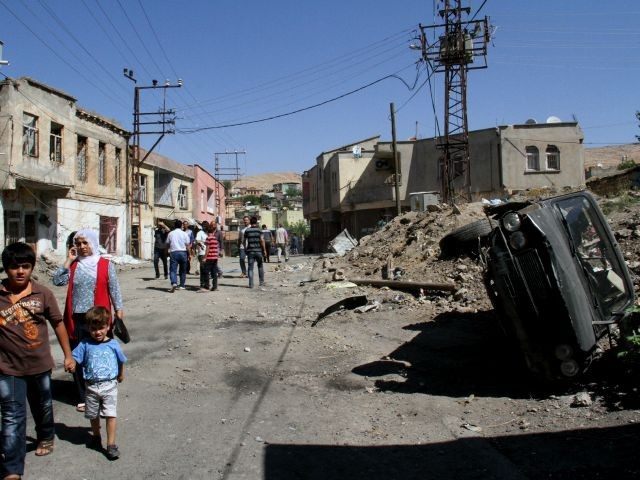Turkish newspaper Hurriyet Daily News sent some reporters to tour the Silvan district of Diyarbakir province in southeastern Turkey on Friday, after two days of fighting between Kurdish PKK separatists (or, more precisely, their “youth wing,” the YDG-H) and Turkish security forces.
The Hurriyet team found locals trying to resume their normal daily lives in a city filled with “charred vehicles, burned down buildings and walls riddled with bullet holes.”
Food and medicine are tight, while shops were riddled with bullets and burned in fires, leaving their owners deprived of property and merchandise. The militants had a penchant for digging ditches through the streets to slow down police forces, and they set up ambushes when attempts were made to fill the ditches. Now that calm has been restored, repairs on the roads are underway.
The death toll from the fighting in Silvan is uncertain, and it will probably be a while before the authorities can confirm it because the YDG-H left a few unpleasant surprises behind. The Hurriyet reporters were shown what appeared to be a dead body partially hidden under a pile of garbage, but it proved to be a dummy booby-trapped with explosives, designed to explode when security forces tried to identify the corpse.
Reporters from the Cihan News Agency also described Silvan as “lying in ruins,” a town that had become a battlefield, describing demolished homes and workplaces, plus burned-out cars in the streets.
Aysegul Aydin and Cem Emrence, authors of a book on the Kurdish insurgency called Zones of Rebellion, note at the Washington Post that the YDG-H is an “intimidating presence” in southeastern Turkish towns, where they use ditch-digging, booby-trap, and ambush techniques similar to what was seen in Silvan.
The authors see the Kurdish insurgency and Turkish response as something of a vicious cycle in which both sides keep employing the same tactics, prolonging a decades-old conflict that has run hot and cold, but never really stopped. The peace process that fell apart recently was viewed as one of the best opportunities for a resolution to the conflict in a generation, but there seems little hope of reviving it at the moment.
“In July, the Kurdish insurgency and the Turkish state went back to old ways of doing business in southeast Turkey,” Aydin and Emrence write. “Neither side, however, has any hope of defeating the other, instead repeating in vain the policies permitted by their institutional memory.” This is, obviously, not good news for civilians caught in the crossfire, whether they’re dealing with Turkish airstrikes or dummies booby-trapped by the PKK.

COMMENTS
Please let us know if you're having issues with commenting.